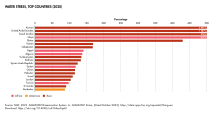Irrigation in Saudi Arabia
This article needs additional citations for verification. (April 2008) |

. Diameters of the normally circular fields range from a few hundred meters to as much as 3 km (1.9 mi).
The projects often trace out a narrow, sinuous, and seemingly random path. Actually, engineers generally seek ancient river channels now buried by the sand seas. The fossil waters mined in these projects accumulated during periods of wetter climate in the Pleistocene glacial epochs, between 10,000 and 2 million years ago, and are not being replenished under current climatic conditions. The projects, therefore, will have limited production as the reservoirs are drained.

A network of
Saudi Arabia is suffering from a major depletion of the water in its underground aquifers and a resultant break down and disintegration of its agriculture as a consequence.[2][3] As a result of the catastrophe, Saudi Arabia has bought agricultural land in the United States,[4][5] Argentina,[6] and Africa.[7][8][9][10] Saudi Arabia ranked as a major buyer of agricultural land in foreign countries.[11][12]
See also
- Desert farming
- Peak water
- Environmental impact of irrigation
- Water politics in the Middle East
External links
References
- . Rome. p. 41–42
- ^ "What California can learn from Saudi Arabia's water mystery". 22 April 2015. Retrieved 26 March 2019.
- ^ "Saudi Arabia's Great Thirst". National Geographic. 10 January 2017. Retrieved 26 March 2019.
- ^ RYOT (9 November 2015). "Saudi Farmers Buy Up US Land After Drying Out Theirs". Retrieved 26 March 2019 – via YouTube.[dead YouTube link]
- ^ "Saudi dairy giant Almarai buys agricultural land in USA". english.alarabiya.net. Retrieved 26 March 2019.
- ^ "Saudi firm buys farmland in Argentina to secure animal feed". USATODAY.COM. Retrieved 26 March 2019.
- ^ "Outsourcing's third wave". 21 May 2009. Retrieved 26 March 2019 – via The Economist.
- ^ Wilkerson, Michael. "Why is Saudi Arabia buying up African farmland?". Retrieved 26 March 2019.
- ^ Aburawa, Arwa. "African Land Grab Continues – Middle East Is Major Buyer". Green Prophet. Retrieved 26 March 2019.
- ^ "An incredible image shows how powerful countries are buying up much of the world's land". The Washington Post. 2015-05-21. Retrieved 2019-03-26.
- ^ Khetani, Sanya. "These 14 Countries Are Buying Incredible Amounts Of Foreign Land In Deals You Never Hear About". Business Insider. Retrieved 26 March 2019.
- ^ Demick, Barbara. "China looks abroad for greener pastures". latimes.com. Retrieved 26 March 2019.
